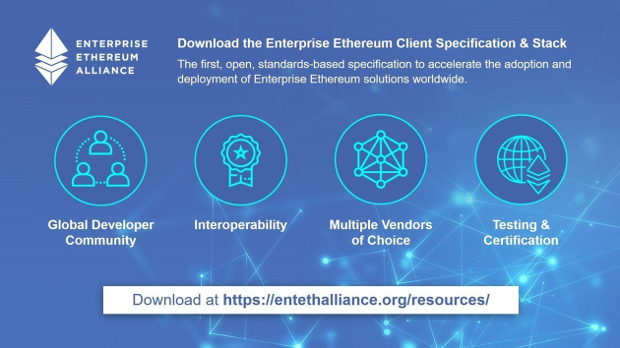A blockchain standards group made up of hundreds of businesses and tech development members has unveiled its first specification for enabling the development of peer-to-peer, decentralised networks explicitly for automating corporate transactions.
The Enterprise Ethereum Alliance (EEA) last week released the Enterprise Ethereum Client Specification 1.0, an open source framework to speed business transactions, boost privacy for contracts and create a faster, more efficient business transaction workflow.
The EEA Specification and its architecture stack is based on blockchain components developed by the Ethereum Foundation, the organisation behind the world’s second most valuable cryptocurrency: Ether.
By using the EEA’s new specification, developers can write code that enables interoperability between businesses and their customers, either over a permissioned or public blockchain. The specification sets up a framework for setting up permission to join a blockchain network.
“You think about where Ethereum currently sits. It has great core competencies around value transfer, sending people Ether. It’s created the standard for fundraising through token offerings [initial coin offerings],” said Tom Lombardi, EEA’s head of market development. “But the goal of the alliance is to build a framework where we can use Ethereum, which has the largest developer base in the world, in a corporate setting.
“These large companies have compliance hurdles, legal hurdles and certain levels of bureaucracy where they have to check all the boxes before they can use a technology like this,” Lombardi said.
Off the chain
The blockchain specification and its architectural stack promises greater transactional efficiency because it allows data to be taken ‘off-chain,’ or outside the primary blockchain ledger and processed in a separate database behind a firewall. The primary blockchain is then only used to validate completed transactions and can create a separate hash to represent the data offline for privacy and security.
Processing information off-chain is becoming a popular concept for increasing the efficiency of blockchain networks, which can take many minutes to process a single transaction. For example, bitcoin on average takes 10 minutes to process a transaction.
“Ethereum only has 13 or 14 transactions per second and that’s not suitable for enterprise demand,” Lombardi said. “Not everything has to occur on-chain.”
The Enterprise Ethereum Client Specification was created by a technical steering committee that will work on expanding it with member contributions through October with the goal of publishing Enterprise Ethereum Client Specification 1.1. That spec will include more frameworks for business-specific applications.
“Every member gets one vote, whether it’s a small or large company,” EEA executive director Ron Resnick said during the announcement last week. “In time for that, we’re working on the implementation of a certification programme. And that certification program will be based on version 1.1.”
Public blockchain ledgers, such as bitcoin, have no central authority; the ledger is governed by a consensus mechanism among users. Conversely, a private or ‘permissioned’ blockchain has a central administrator that vets those who are then allowed to join the blockchain.
A permissioned blockchain, for example, might be used among business partners who have a common purpose – such as cross-border financial transactions or supply chains. International companies can also create internal, permissioned blockchains to transact between various divisions or business units.
Token efforts
Along with permissioned blockchains, businesses can also use public blockchains to crowdfund projects by selling cryptocurrencies through initial coin offerings – in this case, Ether tokens – or to promote customer loyalty by issuing tokens.
For example, some businesses are considering the use of blockchain networks for customers to trade loyalty points as tokens on an exchange. A customer purchases so many groceries, then gets so many tokens to trade with. The value of the token, like any cryptocurrency, is determined by the marketplace.
The Ethereum organisation’s blockchain is a series of protocols that define a platform for decentralised applications or dApps.
Like other business blockchains, such as Hyperledger, Ethereum has the capability to execute ‘smart contracts,’ a business automation tool. When certain conditions of a contract are met, the blockchain executes commands. For example, in a real estate transaction, once all parties have agreed to the terms of a deal by entering their consent on the blockchain – and the banks have approved a money transfer – the blockchain can automatically execute that transaction.
Ethereum’s smart contract capability is called the Ethereum Virtual Machine (EVM) and it can execute code of arbitrary algorithmic complexity. Developers can create applications that run on the EVM using friendly programming languages modeled on existing languages like JavaScript and Python.
“We think by the first part of 2019 we should be in a good place for implementing certification,” Resnick said. “And it allows all the developers actually to get involved and see what we’re doing. We anticipate great things due for the rest of the year.”
IDG News Service






Subscribers 0
Fans 0
Followers 0
Followers